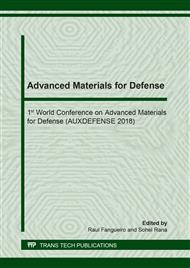[1]
F. Ade, Ballistic qualification of armour steel weldments, Weld. J, 70 (1991) 53-56.
Google Scholar
[2]
G. Madhusudhan Reddy, T. Mohandas, Ballistic performance of high-strength low-alloy steel weldments, J. Mat. Proc. Tech. 57 (1996) 23-30.
DOI: 10.1016/0924-0136(95)02041-1
Google Scholar
[3]
G. Madhusudhan Reddy, T. Mohandas, KK. Papukutty, Enhancement of ballistic capabilities of soft welds through hardfacing, Int. J. Imp. Eng. 22 (1999) 775-791.
DOI: 10.1016/s0734-743x(99)00020-2
Google Scholar
[4]
M.Balakrishnan. V. Balasubramanian and G. Madhusudhan Reddy, Effect of Hardfaced Interlayer Thickness On Ballistic Performance of Armour Steel Welds, Mater. Des. 44 (2013) 59–68.
DOI: 10.1016/j.matdes.2012.06.010
Google Scholar
[5]
M.Balakrishnan. V. Balasubramanian and G. Madhusudhan Reddy, Effect of PTA Hardfaced Interlayer Thickness on Ballistic Performance of Shielded Metal Arc Welded Armour Steel Welds, Journal of Mater. Eng. Per. 22(3) (2013) 806-813.
DOI: 10.1007/s11665-012-0338-5
Google Scholar
[6]
M.Balakrishnan, V. Balasubramanian and G. Madhusudhan Reddy, Effect of Hardfaced Interlayer Thickness and Low Hydrogen Ferritic Capping On Ballistic Performance of Shielded Metal Arc Welded Armour Steel Joints, J. Iron Steel Res. Int. 20 (12) (2013) 82-91.
DOI: 10.1016/s1006-706x(13)60220-4
Google Scholar
[7]
M.Balakrishnan, V. Balasubramanian G. Madhusudhan Reddy and P. Parameshwaran, Effect of capping front layer materials on the penetration resistance of Q&T steel welded joints against 7.62 mm armour-piercing projectile, Metall. Mater. Trans. A, 44 A (2013) 4218-4229.
DOI: 10.1007/s11661-013-1794-8
Google Scholar
[8]
M.Balakrishnan, V. Balasubramanian and G. Madhusudhan Reddy, Microstructural analysis on ballistic tested armour steel joints, Metall. Micro. Anal. 2(3), (2013) 125-139.
DOI: 10.1007/s13632-013-0069-5
Google Scholar
[9]
M.Balakrishnan, V. Balasubramanian and G. Madhusudhan Reddy, Effect of joint design on ballistic performance of Q&T steel joints, Mater. Des. 54 (2014) 616-623.
DOI: 10.1016/j.matdes.2013.08.084
Google Scholar
[10]
M.Balakrishnan, V. Balasubramanian and G. Madhusudhan Reddy, Effect of hardfacing consumables on ballistic performance of Q&T steel joints, Defense Tech. 9 (4) (2013) 249-258.
DOI: 10.1016/j.dt.2013.12.007
Google Scholar
[11]
M.Balakrishnan, V. Balasubramanian and G. Madhusudhan Reddy, Effect of hardfacing process on ballistic performance of Q&T steel joints, Mater. Perf. Char. -ASTM, 3 (1) (2014) 265-284.
DOI: 10.1520/mpc20130021
Google Scholar
[12]
M. Balakrishnan, V. Balasubramanian, G. Madhusudhan Reddy, Sivakumar K. Effect of buttering and hardfacing on ballistic performance of shielded metal arc welded armour steel joints, Mat. Des. 32 (2011) 469 -79.
DOI: 10.1016/j.matdes.2010.08.037
Google Scholar
[13]
A.G. Odeshi, M.N. Bassim, High strain-rate fracture and failure of a high strength low alloy steel in compression, Mater. Sci. Eng. A. 525 (2009) 96–101.
DOI: 10.1016/j.msea.2009.07.026
Google Scholar
[14]
A.G. Odeshi, S. Al-ameeri, S. Mirfakhraei, F. Yazdani, M.N. Bassim, Deformation and failure mechanism in AISI 4340 steel, under ballistic impact, Theo. App. Frac. Mech. 45 (2006) 18–24.
DOI: 10.1016/j.tafmec.2005.11.005
Google Scholar
[15]
K. Maweja and W. Stumpf, Fracture and ballistic-induced phase transformation in tempered martensitic low-carbon armour steels, Mater. Sci. Eng. A. 432 (2006) 158–169.
DOI: 10.1016/j.msea.2006.06.033
Google Scholar
[16]
S. Deya, T. Børvik, O.S. Hopperstad, J.R. Leinum, M. Langseth, The effect of target strength on the perforation of steel plates using three different projectile nose shapes, Int. J. Impact. Eng.30 (2004) 1005–1038.
DOI: 10.1016/j.ijimpeng.2004.06.004
Google Scholar
[17]
A. Saxena, A. Kumaraswamy, G. Madhusudhan Reddy, Vemuri Madhu, Influence of welding consumables on tensile and impact properties of multi-pass SMAW Armox 500T steel joints vis-a-vis base metal, In Press, Corrected Proof, Available online 31 January (2018).
DOI: 10.1016/j.dt.2018.01.005
Google Scholar
[18]
Y.V. Milman, S I Chugunova, I V Goncharova, V.A. Goncharuk, N.A. Yefimov, Physics of deformation and fracture at impact loading and Penetration. Int. J. Impact Eng. 33 (2006)452-62.
DOI: 10.1016/j.ijimpeng.2006.09.058
Google Scholar


